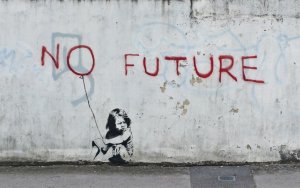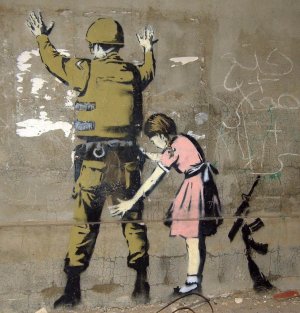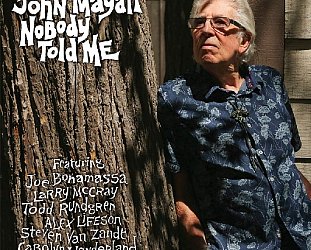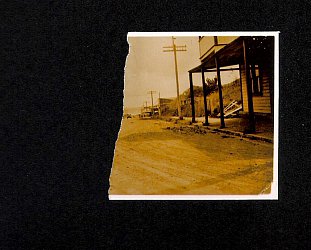Graham Reid | | 4 min read

When, in 2008, Britain's Mail on Sunday identified who it thought to be the anonymous stencil artist Banksy, there were numerous complaints. “Why have you done this? I don't understand,” wrote one disgruntled reader. “You have ruined something special.”
As Robin Barton, owner of Bankrobber Gallery which sells Banksy prints, said, “People really don't want to know who Banksy is. Even collectors don't want to me to tell them who he is.
“It's weird but that's what keeps it fresh for me. In the same way I don't want people to know who he is. Everyone can find out, it should be pretty easy, but it's more fun and much more profitable not knowing.”
Barton is right on all counts; anonymity, fun and profit are among the hallmark's of the Bristol-born street artist's internationally acclaimed career.
 To write this widely sweeping
biography, an account of Banksy's career and market trajectory – as
well as forays into the turf wars of graffiti artists, the contempt
Banksy is held in by some and the acclaim offered by others --
journalist Ellsworth-Jones made it clear to those he spoke with,
Banksy's PR people and friends among them, he had no interest in
revealing the artist's identity.
To write this widely sweeping
biography, an account of Banksy's career and market trajectory – as
well as forays into the turf wars of graffiti artists, the contempt
Banksy is held in by some and the acclaim offered by others --
journalist Ellsworth-Jones made it clear to those he spoke with,
Banksy's PR people and friends among them, he had no interest in
revealing the artist's identity.
Not that anyone would have helped him anyway.
There has been a remarkable and rare cone of protective silence over Banksy's identity even though he has worked in loose collectives and often moved about in public. In an age when there is a relentless pursuit of the most minor or mundane claim to celebrity status, his uniqueness is even more alluring, especially when his art and life is so public: the streets of Britain and the United States, a pop-up gallery in Bethlehem, organising exhibitions and competitions . . .
He has – unseen and uninterrupted – hung his own work in various famous galleries, put a blow-up doll in orange-suited Guantanamo Bay prison clothes beside Disneyland's Big Thunder Mountain, and had Team Banksy substitute Paris Hilton's CD with a remix of his own in altered cover art at 42 record stores across Britain. And painted hundred of stencils on walls.
Ellsworth-Jones traces the artist's origins from Bristol where the middle-class Banksy (not working-class as his publicists say) was part of a group of graffiti artists working in and out of Barton Hill Youth Cub in a tough part of town.
Today it is a strange world he now occupies, his work bought for astronomical sums by Hollywood actors and art collectors, his street art protected by councils (to the ire of others whose work is painted out) and, most interestingly, Banksy's seeming indifference to the whole thing other than to be allowed to continue working and maintaining his anonymity.
 He sanctions some prints and has lately
taking to signing them to stave off frauds, rarely authenticates his
street art (although identifies fakes to the chagrin of gullible
investors) and seems genuinely indifferent to amassing wealth.
He sanctions some prints and has lately
taking to signing them to stave off frauds, rarely authenticates his
street art (although identifies fakes to the chagrin of gullible
investors) and seems genuinely indifferent to amassing wealth.
“The money that my work fetches these days makes me uncomfortable,” he told the New Yorker recently. “But that's an easy problem to solve – you just stop whingeng and give it all away. I don't think it's possible to make art about world poverty and trouser all the cash. That's an irony too far, even for me.”
He turns down major offers from advertisers like Nike who want to commission him, lets anyone download images from his website for free for personal use (“However, making your own art or merchandise and passing it off as ‘official’ or authentic Banksy artwork is bad and very wrong”)and does give large amounts of money away (sometimes anonymously, sometimes not).
He doesn't make a penny from most of his art which appears on detritus like coffee cups and t-shirts, although he could. Sometimes his work is done by a team but he is always actively involved in the planning and often part of the team when executing big works. He has organised large scale events involving dozens of people yet has remained anonymous even though many have spoken with him and either not known it was Banksy or have kept their counsel.
He speaks through intermediaries or by e-mail (which meant the Observer's Music Monthly came within a whisker of running an “interview” by an impostor) and has been a lifeline for galleries such as the century-old and under-patronised Bristol City Museum he held in such affection that he put on a typically witty installation show there in 2009 which he underwrote, and controlled the publicity of, entirely.
The gallery drew almost five times as many visitors as the previous July – 4000 a day – and the exhibition was the second most visited in Britain that year after the Saatchi and Saatchi show of new work from China.
In this highly readable book, Ellsworth-Jones tells of other exhibitions where the queues were hours long and how Banksy's work came to be as common in Sotheby's as a street wall in East London.
But within the graffiti world – those guerilla attacks by old-school writers – Banksy's stencil style is held in contempt and he has admitted he wasn't good at freehand graffiti: “Too slow.”
Stencils are too easy, too glib, his streetcorner critics say, and Banksy art has been anointed and protected by the art world and civic authorities.
But they are in a minority. Banksy's business may be big business – Ellsworth-Jones offer a detailed account of their increasingly value – but often it seems others have cashed in more than he has. Not that he – the anonymous outsider and widely acknowledged polite, smart and funny “good geezer” – seems to care.
“I love the way capitalism finds a place,” he has said. “Even for its enemies.”
For more on Banksy go here, and for wall art of all kinds from around the world go here.





post a comment